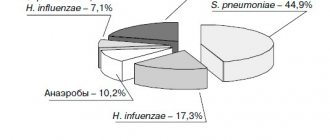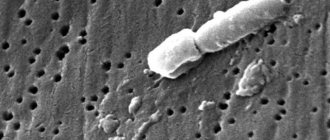Messages have appeared on the social network Twitter about a superbug that cannot be “killed” by any of the antibiotics proposed for treatment. One of the Belarusian users demonstrated the results of a sensitivity test for Klebsiella pneumoniae: the photo of the form shows that opposite the name of each of the 24 antibiotics that can be treated, there is a letter “R”, indicating resistance (resistance).
Klebsiella pneumoniae Photo: Public Domain
Foreign doctors have encountered a similar situation more than once. Thus, in 2021, American scientists discovered a rare strain of this superbug, which turned out to be resistant to most antibiotics used in the United States, in more than a third of the examined patients in Houston clinics.
In the same year, information appeared in the press about the death of a 70-year-old patient in the United States after being infected with the superbug Klebsiella pneumoniae: doctors were unable to save the woman because the bacterium turned out to be resistant to all 26 antibiotics that could be used for treatment. As a result, the patient died from sepsis (blood poisoning). And in 2012, The Washington Post reported that six patients died in an outbreak of an antibiotic-resistant strain of Klebsiella pneumoniae at a National Institutes of Health hospital.
Question answer
What is a superbug?
What kind of bacterium is Klebsiella pneumoniae and why is it dangerous?
We are talking about an anaerobic rod-shaped bacterium from the genus Klebsiella, which is found everywhere in the environment, including soil and surface waters. Klebsiella was discovered in 1882 by German microbiologist Karl Friedländer , which is why its second name is Friedländer's wand. This opportunistic bacterium lives in the human body without showing itself at all, as long as a healthy balance is maintained and optimal microflora is maintained. It becomes dangerous only when the “good” bacteria weaken or their number sharply decreases.
Friedlander's bacillus can cause a variety of pathologies, including sepsis, urinary tract infections, bacteremia, meningitis and liver abscesses. Quite often, Klebsiella is the cause of acute pneumonia. People with immunodeficiencies, severe concomitant diseases and a weakened immune system are most often susceptible to infection.
Klebsiella pneumoniae is especially dangerous for humans. It is the predominant causative agent of nosocomial infections in a number of hospitals. The source of infection, as a rule, is a sick person or a bacteria carrier. The most common routes of transmission are foodborne, airborne and household contact.
Klebsiella symptoms
Klebsiella can cause diseases such as:
- pneumonia;
- inflammation of the urinary tract;
- meningitis
; - conjunctivitis;
- intestinal infections;
- sepsis;
- ozena;
- rhinoscleroma.
Pneumonia
and intestinal lesions are the most common diseases caused by Klebsiella. If you have symptoms of all these diseases, you should immediately consult a doctor, since untimely treatment can aggravate the course of the disease itself and cause all sorts of complications against its background.
Where can you get infected with Klebsiella pneumonia and can it be cured?
“Klebsiella pneumoniae is now increasingly the causative agent of infection within hospitals. It is one of the so-called nosocomial infections. The bacterium is now acquiring multiple resistance to most modern antibiotics. But the truth is that most resistance mechanisms are already understood, and new antibacterial drugs are being developed that overcome this resistance. Yes, of course, Klebsiella poses a threat if you do not understand in time that the infection is caused by it. In this case, everything could end badly. But if we know for sure that the cause of the disease is this bacterium, and we know its resistance mechanisms, then doctors have certain opportunities to fight it. “Everything is not entirely so hopeless,” says doctor, clinical pharmacologist, head of the department of general and clinical pharmacology at RUDN University Sergei Zyryanov .
Klebsiella in infants
In infants, the symptoms of the disease are more pronounced. First of all, this concerns body temperature. In children it always reaches high levels.
The intoxication of the body is severe, nausea, vomiting, diarrhea are always present, and signs of dehydration quickly increase. The child becomes restless, cries all the time, and refuses to eat.
If Klebsiella penetrates the mucous membrane of the eye, the child develops conjunctivitis: lacrimation increases and pus appears.
Treatment should be started as early as possible. With an integrated approach, recovery in children occurs faster than in adults.
Why is Klebsiella becoming increasingly resistant to antibiotics?
Bacteria are increasingly adapting to antibiotics and passing on the resistance gene to other bacteria, thus creating superbugs. These are pathogens of infectious diseases that are resistant to several antibiotics traditionally used to treat these diseases. The ability of superbugs to resist antibiotics is causing concern in the international community; the problem is even being discussed at the level of the UN General Assembly.
“So, unfortunately, what happens is that all the microbes that live in hospitals become more stable and resistant, since in medical organizations antibiotics are often prescribed for treatment. This makes microbes more resistant to various influences, and doctors have to use more force and more costs associated with treating such an infection,” says Zyryanov.
Unlike other bacteria, Klebsiella has the ability to form a capsule, which makes it stable in the external environment. This capsule protects the pathogen from drying out, so Klebsiella can be stored for a long time at room temperature. Most strains of Klebsiella pneumoniae are immune to penicillins, cephalosporins of III-IV generations, aminoglycosides, and fluoroquinolones.
Article on the topic
What will we replace antibiotics with when they stop working?
As American doctors previously noted, a particular problem is that some strains of Klebsiella have also become more resistant to carbapenem antibiotics. These drugs were previously considered most effective in treating infections caused by Klebsiella pneumoniae, but have begun to lose effectiveness in recent years.
Who is at risk?
The bacterium can infect the body of any person, but most often people with weakened immune systems are affected. The risk group includes HIV-infected people and patients with cancer, as well as people who have undergone chemotherapy. Children of preschool and primary school age are often infected with Klebsiella.
Elderly people and pregnant women are most at risk. Their immunity is weakened, which means the microbe can become active at any time. Additional risk factors are: stress, vitamin deficiency, overwork.
What treatments are there for Klebsiella pneumoniae?
According to Zyryanov, it cannot be said that none of the antibiotics has an effect on Klebsiella. There are new antibacterial drugs that are created specifically to overcome Klebsiella resistance. To obtain the effect of treatment, a combination of already known drugs is also used.
Treatment with a higher dose of antibiotics may have a therapeutic effect, but it all depends on the specific strain of bacteria, the specific antibiotic and the patient’s condition. “Increasing the dose, depending on the specific antibiotic, may have an effect on the bacterium. It also depends on what strain of Klebsiella we are talking about. There are certain indicators of resistance, if they allow this to be done, then this method is used. In some cases, increasing the dose really helps,” says Zyryanov.
Lungs under attack. What types of pneumonia are there and how to treat them? More details
In addition, the doctor notes that it is almost impossible to become infected with this superbug outside the hospital. “Klebsiella pneumonia, which is extremely drug resistant, practically does not exist in community settings. It’s a hospital pathogen,” he says.
Treatment of Klebsiella
Treatment of Klebsiella
, or rather the diseases caused by it, depends on the localization and severity of the pathological process.
The most unpredictable thing is that, for example, intestinal diseases are caused by mixed flora. In other words, diagnosis becomes more difficult, but treatment, if the disease is caused by Klebsiella, is carried out with bacteriophages and drugs that can restore normal intestinal microflora.
Antibiotics are used extremely rarely.
Also, when treating diseases caused by Klebsiella, special attention is paid to restoring the patient’s immunity.
In any case, if you notice symptoms of diseases that can be caused by Klebsiella, you should immediately seek help from a doctor.
Pathogenesis
Since Klebsiella is the etiological agent of a number of diseases of various human organs and systems, the pathogenetic processes in each disease differ significantly. Therefore, we will briefly consider only the pathogenesis of pneumonia.
The entry point for infection is most often the damaged mucous membrane of the respiratory tract. Less commonly, endogenous spread of the infectious agent occurs. Colonization of the oropharynx with Klebsiella is observed mainly in weakened individuals and patients suffering from alcoholism . Against the background of a decrease in the overall reactivity of the body and a pronounced weakening of bronchopulmonary protection factors, Friedlander's bacillus (outdated name K. Pneumoniae) begins to actively multiply in the lung tissue.
Under the influence of endotoxin, vascular permeability increases and the lung parenchyma is destroyed. The inflammatory process quickly progresses and spreads in the lung tissue, lung abscesses form, which is facilitated by the release of biologically active substances by the cells of the immune system. Pathomorphological examination reveals changes characteristic of lobar pneumonia . The entire lobe of the lung may be involved in the pathological process, inflammatory exudate is found in the pleural cavities, and there are areas of destruction (destruction) of the lung tissue.
Complications and prognosis
If treatment was started on time, the prognosis is favorable. After recovery, all systems are quickly restored, the person feels absolutely healthy.
Lack of therapy leads to the disease becoming chronic. This threatens the development of complications, including:
- Respiratory failure.
- COPD
- Gastritis.
- Stomach ulcer.
- Pyelonephritis.
- Enteritis.
- Pharyngitis, tonsillitis, laryngitis.
What tests need to be done to identify the bacteria?
Symptoms of Klebsiella activation appear 1-2 weeks after the onset of the disease.
The following tests may be tried to make a diagnosis:
- BAK urine culture.
- Stool analysis.
- Blood analysis.
- LHC analysis of throat swab.
- Tank analysis of a smear from the cervical canal.
If there is a suspicion that microbes are multiplying in the lungs, radiography is necessary.
Klebsiella infection of the upper respiratory tract
If Klebsiella pneumoniae is detected in a nasal smear in a child or adult, the patient must be hospitalized. In addition to inflammatory processes in the lung tissue, the mucous membranes of the nose, larynx and trachea can be affected.
In this case, the disease is characterized by the development of rhinoscleroma. At the same time, the nose becomes swollen. Red nodules covered with healthy tissue appear on the nose. Breathing through the nose becomes difficult.
When examining the nasal passages, foci of inflammation are observed, the mucous membrane is swollen and hyperemic. With the naked eye you can see nodular formations - granulomas.
When the integrity of granulomas is violated, ulcers appear that bleed. Next, the affected areas dry out, forming crusts. It is in them that the pathogens of the disease are concentrated.
When examining a nasal swab, chains of Klebsiella are sown. Subsequently, the crusts begin to become covered with connective tissue. Purulent mucous discharge appears, with a foul odor. Body temperature rises to high levels.
Diseases of the trachea, nasopharynx and larynx are caused by Klebsiella ozena. The patient suffers from high fever and symptoms of general intoxication.
The danger of damage to the upper respiratory tract lies in tissue atrophy and deformation of the nasal bones . The resulting crusts impair respiratory function. A viscous purulent exudate accumulates in the nasopharynx, discharged when coughing.
Interpretation of analyzes
By comparing the data obtained with normal values, doctors interpret the result.
Analysis of urine
Several indicators need to be taken into account at once. If there are 1-2 Klebsiella in the laboratory technician’s field of view, this is not a deviation from the norm. An infection of the urinary system is indicated by a significant excess of their numbers.
Be sure to evaluate the number of squamous epithelial cells and leukocytes. If a person has been exposed to a bacterial infection, their levels will be elevated.
Stool analysis
Damage to the organs of the digestive system will be indicated by a level of Klebsiella in the feces above 105 per 1 g. The number of microbes will begin to increase gradually; in the early stages of the development of the disease there are no symptoms. They appear abruptly only with a rapid increase in the number of microbial flora. These include:
- Bloating.
- Unmotivated thirst.
- High body temperature.
- Intestinal colic.
- Diarrhea with mucus and blood.
Blood analysis
Infection is indicated by values above 105. Antibodies appear in the blood serum, which the body will produce in response to the activation of pathogenic flora.
Throat swab analysis
Normally, there should be no Klebsiella in the throat. They are able to live in the nasopharynx, but their number is minimal, so conventional tests simply do not recognize them. As the disease progresses, the number of microbial flora increases.
Analysis of mucus from the cervical canal
If Klebsiella is present in a smear taken from the cervical canal, then in-depth diagnosis and treatment are required. Normally, these bacteria should be absent there.
Normal indicators
Contamination of the baby's mouth and intestines with Klebsiella occurs within a few days after birth. Normally, the number of bacteria should not exceed 105.
In adults, this figure is lower, it is 85.
If these values are outside the normal range, the balance of the microflora will be disrupted and the person will develop inflammation. The decision about the need to start therapy should be made by the doctor. Each case is individual, since an increase in the number of bacteria does not always indicate the development of the disease.
Classification
According to the classification in the latest edition, the genus Klebsiella belongs to the family Enterobacteriaceae, the class Gammaproteobacteria, the kingdom Bacteria, which includes the following species/subspecies of bacteria:
- Klebsiella pneumoniae (pneumonia) - subspecies: Klebsiella pneumoniae; Klebsiella pneumoniae ozaenae; Klebsiella Rhinoscleromatis.
- Klebsiella aerogenes.
- Klebsiella granulomatis.
- Klebsiella milletis.
- Klebsiella michiganensis.
- Klebsiella oxytoca (oxytoca).
- Klebsiella cf. planticola B43.
- Klebsiella senegalensis.
- Klebsiella quasipneumoniae.
- Klebsiella steroids.
- Klebsiella variicola.








